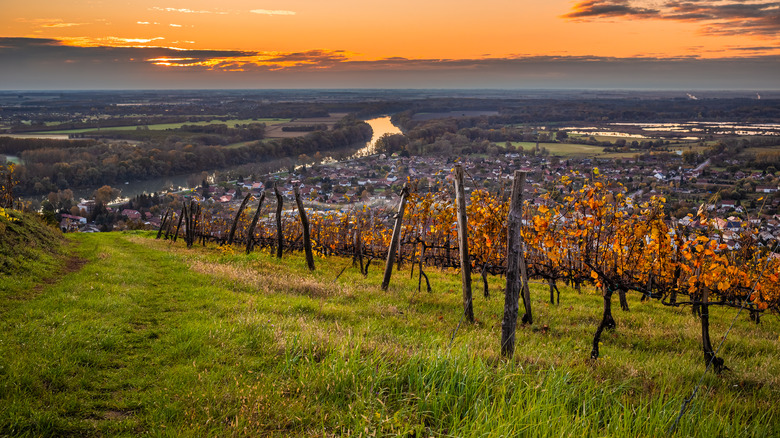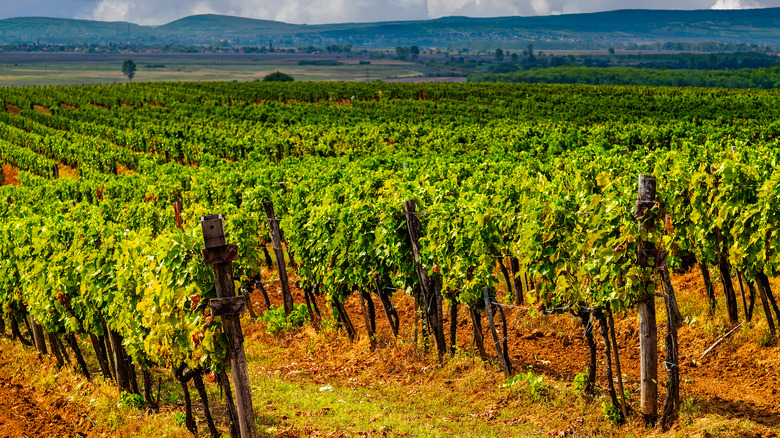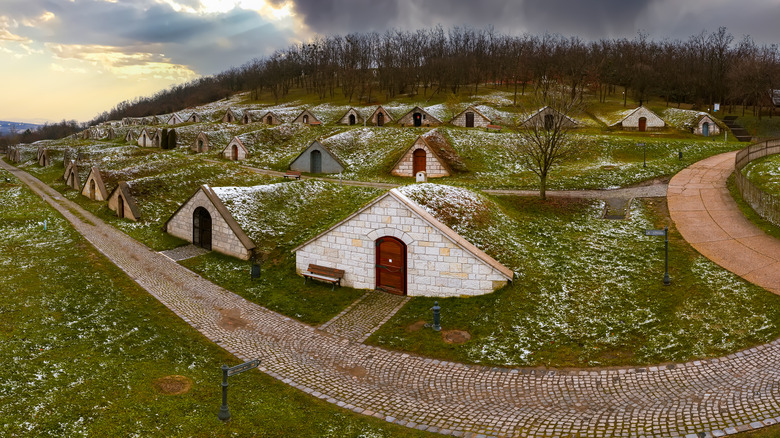Situated on the lush rolling hillsides of Hungary’s northeastern Tokaj wine region, Hercegkút is the epitome of a picture-perfect European village. This sleepy town is one of 27 Tokaj villages, known for its harvest of sweet wines and distinctive architecture. Characterized by a labyrinth of wine cellars called “Hobbit Houses,” because of their triangle-shaped exteriors and short entryways, their unusual shape makes Hercegkút look like a village straight out of a fairytale. Each Hobbit House is blanketed with a cover of lush greenery that helps them blend seamlessly into the natural landscape — and contributes to their photogenic appearance.
The slabs supporting each Hobbit House were hand-chiseled by German peasants from volcanic rock formed hundreds of years ago. The four-level cellar system in Hercegkút comprises nearly 3,000 Hobbit Houses, and tours of the underground chambers reveal a sacred glimpse into the region’s winemaking history. Tucked 32 to 131 feet below the surface soil, each Hobbit House houses a stash of centuries-old wine lined on concrete shelves and covered in dusty cobwebs. Furmint and hárslevelű account for 90% of the native grapes grown in Hungary, with furmint being the most prominent. The wine produced in the Tokaj region was prized as liquid gold (it’s believed the Swiss alchemist Paracelsus even attempted to extract gold from the sweet nectar). It was the royal drink of choice served in the Versailles Court and was presented as a gift to King Louis XIV by the Prince of Transylvania.
History of the Tokaj wine region

A token of great pride for Hungary’s prospering viticulture scene, the Tokaj wine region is a designated UNESCO World Heritage Site that preserves its cultural and ancestral history. The wine produced in this region is steeped in royal heritage and praised by the ancient Kings of the land as some of the finest wines ever made. The land’s unique terroir, geological position, and volcanic soil create a near-perfect climate for growing the sweet grape varieties Hercegkút is known for.
Winemaking in the Tokaj region is the result of Italian, French, and German influence, and the early immigrants taught local vintners proper pruning and planting techniques. The land on which the vineyards rested was owned primarily by wealthy, aristocratic families who controlled the wineries in the region. During the late 1800s, the horrifying phylloxera bug epidemic rampaged the vineyards in Hercegkút and would not return to their thriving state for another 100 years. Following the Communist Era, the vineyards were nationalized, creating space for international and family-owned wineries to flourish.
The sweetness of Tokaj grapes results from the vines’ ability to attract the botrytis fungus, which causes the grapes to have a higher concentration of fruit sugars at the time of harvesting. As a naturally acidic grape, the botrytis fungus balances the flavor profile, producing a sweet and complex full-bodied wine. The humid microclimate plays an important role in the long-term aging and overall texture of the grapes.
Make the most of your time in Hercegkút

Hercegkút may be small in size, but the treasure of this region contains more than meets the eye. Teeming with rich cultural history, it’s worth spending at least a few days in Hercegkút’s famous wine-producing province. What would be a trip to Hungary’s Tokaj wine region without visiting some local wineries? Espák Winery is one of the most popular vineyards in the Tokaj region. This family-owned winery was built on the traditions and accomplishments of the first German immigrants — Swabics — who first cultivated the land in Hercegkút.
Founded by Hercegkút local, Pál Espák and his father, Espák Winery draws from the customs of generations before them. The winery’s cellar dates back to the 1800s, but the addition of modernized tasting rooms and dining areas in 2009 means guests are treated to a full experience of the region’s treasure. Complementing wine tastings of the region’s native harvest are freshly prepared pizzas, baked bread, and full-course dinners. The wines produced at this local winery have a sweet, floral flavor profile, with notes of mineral saltiness that are particularly indulgent in the summer.
For an interactive history lesson, visit the Wine and World Heritage Museum in Tokaj. Embellished with Italian frescoes, this copf-style townhouse creates an interactive experience that showcases the history of the Tokaj wine region through multi-sensory attractions. Visitors can schedule tours of local vineyards and indulge in native food and wine pairings.

